Abstract
Currently, modern power grids are evolving into complex cyber-physical systems integrated with distributed energy resources that can be controlled and monitored by computer-based algorithms. Given the increasing prevalence of artificial intelligence algorithms, it is essential to explore the possibility of energy management in microgrids by implementing control methodologies with advanced processing centers. This study proposes a novel smart multi-agent-based framework under a tendering process framework with a bottom-up approach to control and manage the flow of energy into a grid-connected microgrid (MG). The tendering organization in this structure as an upstream agent allocates demand among generators, creates a balance between supply and demand, and provides optimal energy cost for the MG. To optimize the electricity cost and decrease the use of grid power, the first-price sealed-bid (FPSB) algorithm is implemented over the tendering process. The proposed approach from one side optimally allocates energy among generators, and, from the other side, guarantees the system from blackouts. Theoretical analysis and results demonstrate that the proposed technique is easy to implement and provides a robust and stable control for MGs, which can guarantee energy management as well as flexible and online control. Furthermore, results show the proposed framework besides the real-time allocation of power among providers to optimize the injected power from the grid so that the total injected power by the grid is 146.92 kWh and the injected power to the grid is 214.34 kWh.
1. Introduction
The global desire to increase the penetration of distributed energy resources (DERs) such as WT and PV needs to have an energy-management system focused on the intermittency of renewable generation [1,2]. In particular, the unpredictable change in demand profiles creates more concern regarding the stability, reliability, and supply–demand balance of the electrical system [3,4]. Aggregating energy-storage systems (ESSs) can mitigate this concern. However, this also presents challenges regarding maintaining reliability and stability, which require the regulation of power output of converters [5,6,7,8].
1.1. Literature Review
Over the past decade, several approaches have been presented, such as demand response and day-ahead scheduling, to control and manage the energy in microgrids (MGs) [9,10,11,12,13]. In [14], a day-ahead scheduling approach based on a probability sequence was presented to minimize the cost of electricity purchased from the grid. In [15], the author presented an optimal power scheduling for seaport microgrids using a scalable decomposed method. A multi-objective optimal model was presented by the authors in [16] to manage the demand side and meet consumer satisfaction indicators. Generally, the authors in all studies focus on prediction and optimization by considering various uncertainties without investigating instant control. Therefore, any sudden change can affect the stability and reliability of the power system [17]. Additionally, in such systems, due to designing the system using a top-down approach, the redevelopment of MGs can be challengeable [18]. Therefore, separating control and using distributed energy management based on a multi-agent system can guarantee stability and reliability as well as expandability [19]. A multi-agent system (MAS) as a smart control framework can be introduced to solve this problem in such systems, where individual generators are controlled by autonomous agents [20,21,22]. In MAS, agents can sense the environment, make their own decisions based on their ability, and act on the environment using their actuators [23]. Accordingly, using these properties, a large complex management system can be divided into a set of small management subsystems that can be controlled separately [24,25]. Furthermore, response time is reduced due to parallel processing [26]. Additionally, the autonomous units in the system increase stability and reliability and cause the MAS to act as a decentralized and autonomous control system [27]. The aim of implementing MAS over power systems is to build complex systems composed of autonomous units, called agents, which will operate based on local knowledge and possess a restricted ability, which is capable of pushing the system to the desired global aims. The goal of using online control is to obligate quick responses to sudden changes and improve fault tolerance in the system [28]. Previous studies on energy management have identified the following shortcomings:
- A lack of a comprehensive online energy-management system for minimizing cost function and maximizing the use of DERs. Most of the presented approaches focus on off-line control and scheduling over day-ahead [29,30,31,32,33]
- An absence of an intelligent approach for providing a structure that guarantees stability and reliability [34,35,36]. Generally, most studies in smart grids mainly focus on the generation and demand side without investigating the structure of the control units. However, in smart grids, greater attention must be given to the structure of smart units, control algorithms, and communication among agents, and more research in this direction is quite merited.
- The majority of studies focus on top-down approaches, where central unit controls set points [37,38,39]. However, in smart grids, especially in MASs, this necessitates that the agent regulates set points based on its own abilities.
1.2. Contributions
To create a system with the aforementioned characteristics, the design and structure of a multi-agent system (MAS) is crucial. It ensures the proper operation of the system while promoting cooperation among agents. Therefore, it is necessary to implement a framework that allocates tasks between agents and also design distributed decision units that manage agents in the framework. In this research, a grid-connected DC microgrid is designed where demand is supplied by PV, WT, ESS, MT, and the grid. To control the system, MAS is implemented over the generation and demand side. To manage the MAS, a tendering process framework as a smart contract is implemented where an agent as a tendering organization is responsible for creating coordination and allocating power among agents. Any agent on the generation side is considered to be a bidder to control the power converter by regulating set points. An agent is designed on the demand side that senses load changes and informs the tendering organization. Every one-hour period with changing demand in the MG, the tendering organization holds a new tender among bidders. To encourage bidders to participate in a tender, an award is defined and bidders, after evaluating the condition, send their requested reward to the tendering organization. Bidders in the proposed framework want to increase their pay-off by participating in the tender and satisfying demand. Furthermore, bidders in the tendering process compete to share their service and gain more awards. Because the tender agent’s offer price should be secure from spies, bidders must send their bids in a sealed envelope to the tenderer. To optimize electricity cost in the proposed smart contract, the first-price sealed-bid (FPSB) algorithm is implemented, which allocates power among agents using an iterative algorithm. As a tender is presented by the tendering organization, any producer agent as a bidder sends its offer price based on ability and cost function. The main contribution of this research can be summarized as follows:
- Implementation of a robust online smart energy-management system that enables the control of agents in real time, without requiring any prediction.
- To increase the use of DRSs in the MG, the FPSB algorithm as a competitive algorithm is used to encourage the DER agent to meet demand. This algorithm, by defining awards and iterating the optimal process, enhances the total MG pay-off and decreases power drawn from the grid.
- To have flexible smart control over the system, a MAS structure is implemented that allows users to easily add and remove agents. This feature allows users to redevelop the system without re-configuring the whole structure of the EMS, just by adding or removing the control structure.
- The proposed framework presents an easy implementation and easy redevelopment structure, which provides an indirect interaction construction among agents in the MAS.
- In the proposed approach, decision-making for the agents is completely independent; consequently, this framework can be used in those microgrids that need to redevelop in the future.
- As decision-making in the proposed approach is online, it is not necessary to consider uncertainty, and, at each time period, the tendering organization optimizes the electricity cost. Therefore, it is not necessary to employ day-ahead scheduling in the system.
1.3. Paper Structure
The rest of the paper is organized as follows. Section 2 describes the problem formulation, which covers EMS and the constraint of the system. The framework of energy management, the control algorithm, and the structure of the decision in the MAS are introduced in Section 3. The results are discussed in Section 4, and finally, the conclusions of the research based on the presented results are presented in Section 5.
2. Problem Formulation
To study the proposed method, as shown in Figure 1, a grid-connected DC microgrid is considered with WT and PV as renewable energy resources, a microturbine (MT) as an auxiliary power unit, and a battery as an energy-storage (ES) system to satisfy demand. The generator, through a converter, is connected to the DC load and can be controlled by set points. The system should be able to operate in an isolated and grid-connected mode. Therefore, when the system is in the isolated mode, it must be able to support a balance between supply and demand.

Figure 1.
Simplified model of the microgrid.
To control generation units in the system, a MAS framework is designed where, for any generation, a smart control unit is considered that can sense a signal in the system and act based on its utility and constraints. In the following, the mathematical model of the microgrid and constraints in each component are described.
2.1. Energy Balance Constraint
To stabilize the voltage in the MG, the total generated power should be equal to the total demand.
2.2. WT Constraints
2.3. PV Constraints
2.4. MG Constraints
The following constraints can be considered for MT:
- -
- Turn-on/turn-off constraints
- -
- Ramp up and down limit
- -
- Generation and fuel constraints
2.5. ES Constraints
As shown by Equation (12), the stored energy in ES cannot exceed the minimum and maximum capacity, and every time its SOC can be calculated through Equation (13).
The energy balance of ES during t depends on its charge and discharge state and is gained by Equation (14).
where is a binary variable that shows the charge and discharge mode:
When the ES is in charging mode , the charging power cannot exceed the maximum charge rate, and a similar condition is defined for the discharging mode by Equation (17).
2.6. Grid Constraints
The exchanging power between the grid and MG cannot exceed the minimum and maximum exchanging power of the inverter.
3. Energy-Management Framework
The tendering process framework is generally used by companies and governments to allocate services [40], as well as in robotics [41,42,43] to allocate tasks among robots. Recently, the blockchain has also begun using it to create smart contracts [44,45]. In this paper, to control and manage energy in the system and also to create interaction among agents, the tendering process framework is used. In the proposed framework, there is a tenderer to allocate items, and provider agents as bidders for those who want to sell their provided power as a service. The general schematic of the aforementioned framework is presented in Figure 2. Bidders in each item can express how much their service is worth using their bids. Here, s is a set of items, is used to refer to the utility that agent i derives from item s, and is the evaluation of agent i about item s. The bidder has a valuation function over the item that is presented by the tenderer, and it is the minimum amount that agent i is willing to take for item s. Therefore, the bidder tries to offer an amount that is more than its evaluation to receive more possible profit from each tender.

Figure 2.
General schematic of the tender framework.
3.1. First-Price Sealed-Bid Algorithm
In this research, to allocate demand among generators, a tendering process framework is proposed where bidders request rewards to share power in the MG. In the proposed framework, the tenderer is responsible for allocating demand among generation agents. Figure 3 represents the structure of the framework where all generators are taken into account as bidders who have interactions with the tendering organization, as well as, in some cases, together. To minimize electricity cost in the MG, the FPSB algorithm is used, which allocates power among bidders based on an iterative process. It is assumed that, every hour, a consumer agent reveals the consumed power to the tenderer. As shown in Figure 4, in the beginning, the tendering organization takes demand from the consumer agent and considers it as an item. Then, it announces the requested power () to the bidders (generator agents). Every bidder sends its offer price and power supply to the tendering organization based on its evaluation and available power. Offer prices are given to the tendering organization, which then picks the optimum bid. The tenderer iterates the process to achieve a balance between supply and demand.
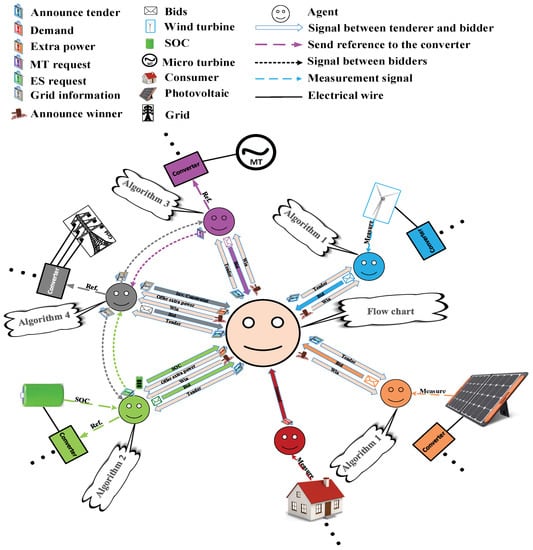
Figure 3.
The implemented framework based on the tendering process on the MAS.
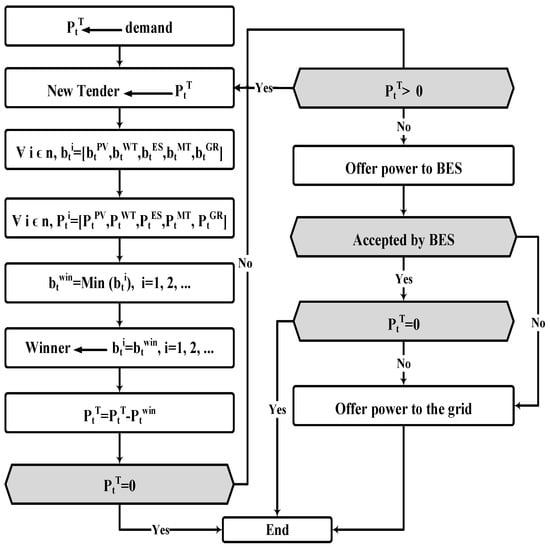
Figure 4.
The flow chart of the FPSB algorithm.
After choosing the winner agent using the tenderer, its provided power is subtracted from the requested power. The tenderer checks the supply–demand balance in the microgrid based on Equation (24). If there is still demand, another tender will be held. If there is extra power in the system, it can be injected into the ES or grid.
3.2. Structure of Decision in the PV/WT Agents
When a tender is announced by the tendering organization, PV and WT agents, based on their own cost functions shown by Equations (25) and (26), send their offer prices. Then, they wait for the tender to be held. Each one is chosen as the winner and sends its own available power to the tenderer. The tenderer considers the supply–demand balance. If there is still demand, the next tender will be held. This will be done until balancing between supply and demand is satisfied. Then, the winners send their suitable set points to their own converters. Algorithm 1 shows the decision structure in PV and WT agents. For these two agents, the decision is similar, but the difference is in their bid amount. After participating in the tender, their revenue can be calculated using Equation (27).
| Algorithm 1: Decision structure of the PV/WT agent. |
 |
3.3. Structure of Decision in the ES Agent
As mentioned, several tenders may be announced for requested power. If the ES bidder for the first and second tenders is not selected as the winning agent, in the third tender, it will decrease its bid based on Equation (28). Therefore, the cooperation of ES agents in satisfying demand could be increased. Based on Algorithm 2, while there is demand in the system, ES injects power into the system, and when extra power exists in the MG, ES can absorb it.
| Algorithm 2: Decision structure of the ES agent. |
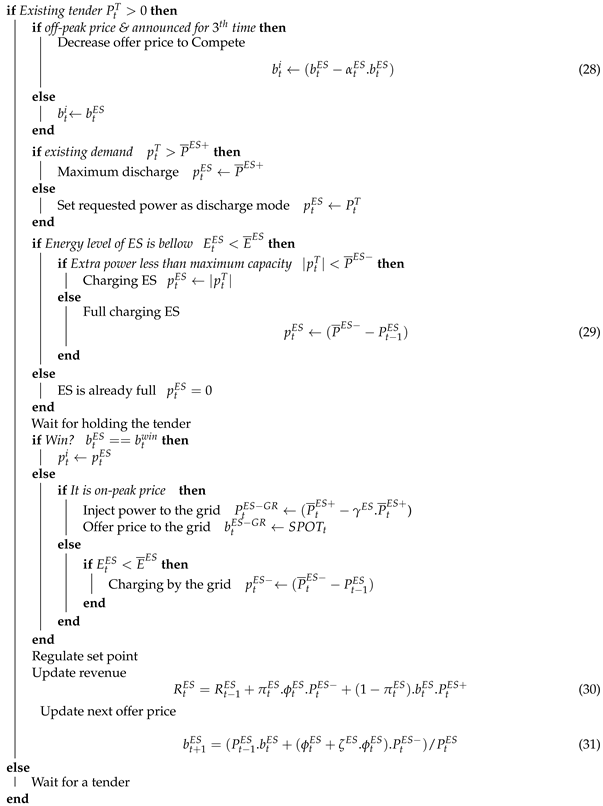 |
During charging mode, based on existing capacity, it can store all the extra power or, as shown in Equation (29), part of the energy. When an ES bidder wins a tender, the tendering organization obtains information regarding the amount of power that can be supplied. At peak prices, if ES loses the tender, it will offer a percentage of the stored power to the grid based on the selling price of the electricity. Otherwise, if ES is not in discharge mode and can store energy, it will be charged by the grid according to TOU. The ES agent sends suitable set points to the converter after ending a tender. At the end of each tender, the ES agent calculates its revenue from each tender and updates its offer price for the next bid using Equations (30) and (31), respectively.
3.4. Structure of Decision in the MT Agent
To decrease the start-up costs of MT, as a tender is announced, the MT agent considers its situation at the previous time. If, at the previous time, it was the supplier, it would offer the maximum price to the tenderer, as shown in Equation (32). If it is off-peak, MT based on Equation (33) would use a discount to compete with the grid. According to Algorithm 3, an MT agent can offer different powers that depend on the requested power, as well as on-peak and off-peak prices. However, its offer power is fixed between minimum and maximum instantaneous power. To gain more profit, it considers the possibility of injecting power into the grid at the on-peak price. If there is not any constraint between the grid and the microgrid, the MT agent will sell power to the grid. When MT is selected as the winning agent, it sends set points to the converter. At the end of each tender, the MT agent calculates its participation revenue using Equation (34).
3.5. Structure of Decision in the Grid Agent
Algorithm 4 represents the cooperation of the grid agent in the system. The grid agent clarifies its offer price based on TOU in the tender. It can inject and receive power as much as its constraints allow. The grid bidder can support the microgrid at any time, to guarantee that there is supply–demand balance in the system. In each step, when the tender is completed, it regulates the set point of the grid-connected inverter. It also updates its revenue from the microgrid using Equation (35).
| Algorithm 3: Decision structure of the MT agent. |
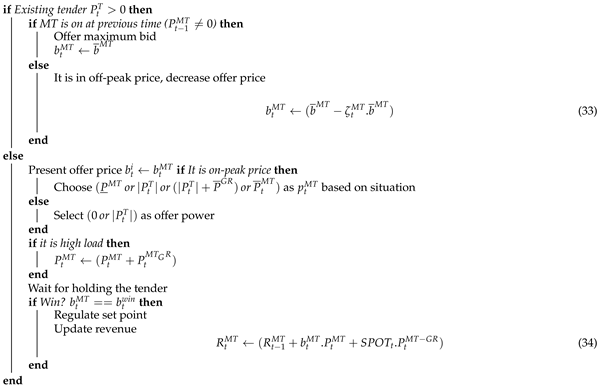 |
| Algorithm 4: Decision structure of the grid agent. |
 |
4. Results
4.1. System Description and Specification
This section evaluates the effectiveness of the proposed algorithm, which was tested on a DC microgrid composed of WT, PV, MT, and ES. These resources are connected to the load through their converters to satisfy demand and transfer power between themselves. In addition, a 30-kW inverter is connected between the microgrid and the utility grid, which supports the balance between supply and demand. Figure 5 represents the selling price of electricity to the grid and the time of electricity consumption. Profiles of the power generated by PV and WT as well as the power demanded are shown in Figure 6 and Figure 7, respectively. Additional required data, i.e., about limitations of generators and bid parameters, are presented in Table 1, Table 2 and Table 3.

Figure 5.
Electricity exchange price (, ).

Figure 6.
Generated power of PV and WT.

Figure 7.
Profile of the load (P).

Table 1.
Constraints of PV and WT agents.

Table 2.
Constraints of ES agents.

Table 3.
Constraints of MT agents.
4.2. Results and Discussions
Figure 8 illustrates the operation results of PV, WT, and MT. It can be recognized that PV and WT agents inject the generated power into the microgrid over 24 h. This is expected in reality because they have the cheapest energy compared to others, but the MT agent behaves smarter than PV and WT. During off-peak, the MT agent does not have any desire to participate in the tender. However, during peak times, as shown, MT is more interested in cooperating in sharing power. During these times, it prefers to produce the highest power to sell to the grid. Through this performance, MT gains more profit at on-peak times rather than off-peak times. For this reason, during peak times, the maximum power is generated and, for the rest of the time, it is in off mode or provides the requested power. From 1400 h to 1900 h, due to the selling price of electricity to the grid being close to its offer price, the strategy of the MT agent is to provide minimum power and stay in reserve. Because of the starting time, the MT agent prefers to be in on mode during these times and have a quick reaction to sudden changes.
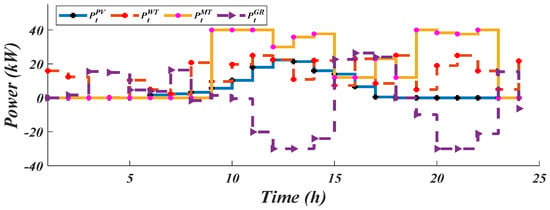
Figure 8.
Operation results of PV, WT, and MT.
Figure 9 shows a grid agent operating over 24 h. It can be perceived that the injected power from the grid is strongly related to electricity price. During off-peak times, it can compete with the rest of the agents and offer low prices. Therefore, the grid agent has more chance to win during off-peak times than on-peak times. However, during on-peak times, the grid agent offers the highest price to the tendering organization. Therefore, it is not able to compete with others. On the other hand, during on-peak times, agents who can provide extra power (as the MT agent can) try to deliver it to the grid and increase their profit. It can be perceived that in reality, such power exchanges between the microgrid and the grid are to be expected.
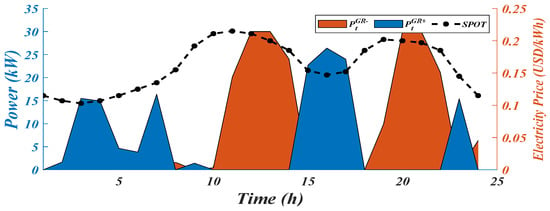
Figure 9.
Injected power from the grid.
It is clear from Figure 10 and Figure 11 that ES is charged only seven times during 24 one-hour period. The performance of ES is accepted because, during this period, while the ES agent participates in the tender, the consumption price for the use of electricity at that time is high. Therefore, during peak times, it can support the microgrid and also inject energy into the grid. Furthermore, due to having less charge/discharge, the life cycle of ES can be guaranteed.

Figure 10.
State of charge of the ES.

Figure 11.
Evolution power of the ES.
In the tendering process, there is a high probability that RESs are selected as a winning agent due to producing cost-effective energy. As shown in Table 4, PV and WT support demand during the day by presenting low-cost energy. At each period, several tenders may be held by the tendering organization to meet demand. The MT agent just participates in the tender during peak times; during off-peak times, its offer power can be zero or minimum because of its higher offer price rather than the others. The grid agent during on-peak times absorbs energy from the microgrid and injects power into the system during off-peak times. The ES agent, based on its capacity and offer price, participates in the tender to meet demand during the day.

Table 4.
Supplied power by agents across 24 h.
Figure 12 shows the offer price of agents during 24 one-hour periods. The ES agent does not participate in the tender during the charge period, and when its SOC is minimum (for example at 0700, 1000, 1400, 1600, and 1800 h). In the beginning, the SOC of ES is 70% and its offer price is 0.13 $/kW. It is charged by WT and its offer price decreases based on Equation (33). When holding the tender, the ES agent tries to compete with the MT and grid agents, for instance at 0200 hrs, ES reduces 5% of its offer price to win the tender (Equation (30)). The ES agent, over 24 h, tries to reduce its offer price to sell power and gain more profit. The MT agent also offers discounts when it is in the reserve state (here between 1500 and 1900 h). During this period, it needs to produce its minimum instantaneous power to be on standby.
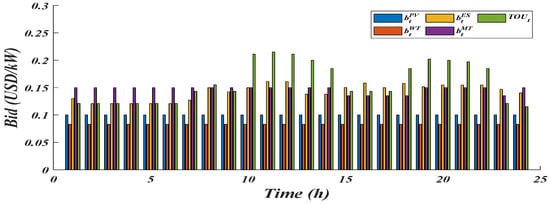
Figure 12.
Offer price of agents.
Figure 13 shows the revenue of agents during a day. A negative amount clarifies that energy is purchased, and a positive defines energy is sold. It is clear that, during peak times, ES and MT agents have high revenue as a result of selling power to the grid. On the contrary, during off-peak times, MT and ES have less desire to participate in the tender and satisfy demand. Therefore, in this period, demand is supported by the grid.

Figure 13.
Revenue of agents over 24 h.
Across 24 one-hour periods, the total amount of power exchanged among agents is 1076 kW. Figure 14 shows the contribution of agents in satisfying demand. During a 24 h period, the power exchanged by the grid is 14%. The total delivered power to the grid is 214.34 kWh, and the absorbed energy from the grid is 146.92 kWh. Therefore, the total price of the absorbed energy is $14.18, and the total price of the injected power is $33.73. Table 5 shows the total revenue of agents by implementing the proposed algorithm. As shown, all the agents make a profit during the day, except for the grid agent (the amount for ES is a pay-off). Selling energy to the grid during on-peak times and purchasing during off-peak times is to be expected.
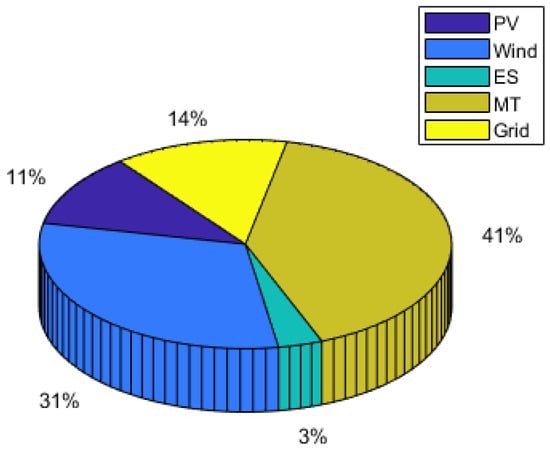
Figure 14.
Percentage of agent participation.

Table 5.
Constraints of the MT agent.
5. Conclusions
In this study, online flexible energy management based on a multi-agent system supervised by a smart contract has been presented and discussed to support the supply–demand balance of a microgrid. In the proposed system, a tendering process framework as a smart contract is used to allocate power among generators. In this framework, the agent as a bidder participates in the tender to share power. To encourage the agent to participate in the tender, an award is used to encourage the agent against satisfying demand. According to the context presented in Section 3, agents must interact with each other to share power between MG and the utility grid to gain more awards during on-peak times. To avoid spying on bidders and optimize electricity costs, the FPSB algorithm was presented, which motivates agents to propose fair prices. In the proposed method, distributed decision structures were implemented in the MAS to control agent interaction in a competitive environment. The proposed framework presents a real-time intelligent energy-management system to optimize the total energy purchases from the grid across a day. The results presented in Section 4 show that the proposed approach allocates power between providers very well and optimizes energy in the system without any prediction and uncertainty consideration. In summary, according to the obtained results, the proposed framework offers the following advantages:
- The proposed mechanism presents an online smart energy-management system without any prediction or day-ahead scheduling.
- The presented approach is easy to implement, even for large-scale systems.
- The tendering process is flexible and scalable, for adding and removing generation devices.
- This structure has high reliability, as the system can continue its operation if some agents fail.
- The implemented smart energy-management system can be easily redeveloped to add new agents into the system due to having distributed decision structures in the MAS.
- The proposed approach optimizes electricity costs in the MG thanks to the use of the FPSB algorithm.
- According to the results, the total power injected into the grid was 146.92 kWh, and the total absorbed power by the grid was 214.34 kWh. Therefore, the proposed approach optimized the purchased energy from the grid.
The challenge for implementing such an intelligent energy-management system over the microgrid is communication among agents and considering the response time in sending and receiving signals to the powered electronic devices. Therefore, studying and implementing a communication protocol among agents in this structure, and analyzing the real-time reliability, should be introduced in future work.
Author Contributions
Conceptualization, methodology, software, investigation, analysis and writing M.S.J.; resources, visualization, supervision, L.R.; resources, writing, preparation, revision E.R.; resources, revision, M.M. All authors have read and agreed to the published version of the manuscript.
Funding
This research received no external funding.
Data Availability Statement
Not applicable.
Acknowledgments
This work was supported by the Secretaria d’Universitats i Recerca del Departament d’Empresa i Coneixement de la Generalitat de Catalunya under 2021 SGR 00392.
Conflicts of Interest
The authors declare no conflict of interest.
Abbreviations
The following abbreviations are used in this manuscript:
| DER | Distributed energy resource |
| EMS | Energy-management system |
| ESS | Energy-storage systems |
| FPSB | First-price sealed-bid |
| Aperture area of PV module (m) | |
| Cell efficiency of PV | |
| Maximum offered price of MT ($/kWh) | |
| , | Maximum and minimum stored energy in ES (kWh) |
| n | Lifetime of unit |
| Maximum discharge and charge rate of ES (kW) | |
| , | Maximum injected power to/ by the grid (kW) |
| Maximum and minimum instantaneous power for MT (kW) | |
| , | Maximum and minimum generated power by PV (kW) |
| , | Maximum and minimum instantaneous power for WT (kW) |
| r | Interest rate |
| Ramp up and down limit (kW) | |
| , | Turn-on and turn-off time (min) |
| Maximum and minimum wind speed for WT (m/s) | |
| MT efficiency (%) | |
| Binary variable of ES | |
| Binary variable of MT (shows on/off condition of MT) | |
| , | Binary variable of MT (shows exploitation condition of MT) |
| MT efficiency | |
| Binary variable that shows absorbing or injecting condition in the grid | |
| t | Time step (h) |
| Investment cost of generator i ($) | |
| Operation and maintenance cost of generator i ($) | |
| Installation cost of PV ($) | |
| Solar panel cost ($) | |
| Fuel cost ($) | |
| Start-up cost ($) | |
| Capacity factor of WT | |
| Stored energy in ES at time t (kWh) | |
| Fuel consumption rate | |
| Solar radiation at time t (W/m) | |
| Requested power by the Tenderer (kW) | |
| , | WT rated power (kW) and speed (m/s) |
| Wind speed (m/s) | |
| Discount applied by ES at time t (%) | |
| Constraint of ES for delivering power to the grid (%) | |
| Profit of ES in selling energy (%) | |
| Discount applied by MT at time t (%) | |
| Offer price for buying energy by ES ($/kWh) | |
| Offered price by bidder i at time t ($/kWh) | |
| Cost to purchase energy | |
| , | Discharging/Charging power of ES at time t (kW) |
| , | Injected power to/by the grid at time t |
| Offered power by bidder i at time t | |
| Revenue gained by bidder i at time t ($) | |
| State of charge of battery at time t (%) | |
References
- Silva, C.; Faria, P.; Vale, Z. Demand Response Implementation: Overview of Europe and United States Status. Energies 2023, 16, 4043. [Google Scholar] [CrossRef]
- Kumar, N.; Singh, G. Comparative Study of Performance About the Integrated Power Quality and Optimized Framework for Smart Grid. J. Technol. Innov. Energy 2022, 1, 33–39. [Google Scholar] [CrossRef]
- Amir, A.; Shareef, H.; Awwad, F. Energy Management in a Standalone Microgrid: A Split-Horizon Dual-Stage Dispatch Strategy. Energies 2023, 16, 3400. [Google Scholar] [CrossRef]
- Mishra, S.; Bordin, C.; Tomasgard, A.; Palu, I. A multi-agent system approach for optimal microgrid expansion planning under uncertainty. Int. J. Electr. Power Energy Syst. 2019, 109, 696–709. [Google Scholar] [CrossRef]
- Habib, M.; Bollin, E.; Wang, Q. Battery Energy Management System Using Edge-Driven Fuzzy Logic. Energies 2023, 16, 3539. [Google Scholar] [CrossRef]
- Rekioua, D. Energy Storage Systems for Photovoltaic and Wind Systems: A Review. Energies 2023, 16, 3893. [Google Scholar] [CrossRef]
- Raihan, A.; Voumik, L.C. Carbon emission reduction potential of renewable energy, remittance, and technological innovation: Empirical evidence from China. J. Technol. Innov. Energy 2022, 1, 25–36. [Google Scholar] [CrossRef]
- Padmanabhan, N.; Ahmed, M.; Bhattacharya, K. Battery energy storage systems in energy and reserve markets. IEEE Trans. Power Syst. 2019, 35, 215–226. [Google Scholar] [CrossRef]
- Zhang, R.; Jiang, T.; Li, W.; Li, G.; Chen, H.; Li, X. Day-ahead scheduling of integrated electricity and district heating system with an aggregated model of buildings for wind power accommodation. IET Renew. Power Gener. 2019, 13, 982–989. [Google Scholar] [CrossRef]
- Gao, C.; Zhang, Z.; Wang, P. Day-Ahead Scheduling Strategy Optimization of Electric–Thermal Integrated Energy System to Improve the Proportion of New Energy. Energies 2023, 16, 3781. [Google Scholar] [CrossRef]
- Zeng, A.; Ho, H.; Yu, Y. Prediction of building electricity usage using Gaussian Process Regression. J. Build. Eng. 2020, 28, 101054. [Google Scholar] [CrossRef]
- Chen, L.; Xu, Q.; Yang, Y.; Song, J. Optimal energy management of smart building for peak shaving considering multi-energy flexibility measures. Energy Build. 2021, 241, 110932. [Google Scholar] [CrossRef]
- Ouammi, A.; Achour, Y.; Dagdougui, H.; Zejli, D. Optimal operation scheduling for a smart greenhouse integrated microgrid. Energy Sustain. Dev. 2020, 58, 129–137. [Google Scholar] [CrossRef]
- Liu, H.; Zhang, Y.; Ge, S.; Gu, C.; Li, F. Day-ahead scheduling for an electric vehicle PV-based battery swapping station considering the dual uncertainties. IEEE Access 2019, 7, 115625–115636. [Google Scholar] [CrossRef]
- Fang, S.; Wang, C.; Liao, R.; Zhao, C. Optimal power scheduling of seaport microgrids with flexible logistic loads. IET Renew. Power Gener. 2022, 16, 2711–2720. [Google Scholar] [CrossRef]
- Li, Y.; Yang, Z.; Zhao, D.; Lei, H.; Cui, B.; Li, S. Incorporating energy storage and user experience in isolated microgrid dispatch using a multi-objective model. IET Renew. Power Gener. 2019, 13, 973–981. [Google Scholar] [CrossRef]
- Selseleh Jonban, M.; Akbarimajd, A.; Javidan, J. Intelligent fault tolerant energy management system with layered architecture for a photovoltaic power plant. J. Sol. Energy Eng. 2015, 137. [Google Scholar] [CrossRef]
- Caspari, A.; Tsay, C.; Mhamdi, A.; Baldea, M.; Mitsos, A. The integration of scheduling and control: Top-down vs. bottom-up. J. Process Control 2020, 91, 50–62. [Google Scholar] [CrossRef]
- Dorri, A.; Kanhere, S.S.; Jurdak, R. Multi-agent systems: A survey. IEEE Access 2018, 6, 28573–28593. [Google Scholar] [CrossRef]
- Mocci, S.; Natale, N.; Pilo, F.; Ruggeri, S. Demand side integration in LV smart grids with multi-agent control system. Electr. Power Syst. Res. 2015, 125, 23–33. [Google Scholar] [CrossRef]
- Sun, F.; Yu, M.; Wu, Q.; Wei, W. A multi-time scale energy management method for active distribution networks with multiple terminal soft open point. Int. J. Electr. Power Energy Syst. 2021, 128, 106767. [Google Scholar] [CrossRef]
- Anvari-Moghaddam, A.; Rahimi-Kian, A.; Mirian, M.S.; Guerrero, J.M. A multi-agent based energy management solution for integrated buildings and microgrid system. Appl. Energy 2017, 203, 41–56. [Google Scholar] [CrossRef]
- Ferber, J.; Weiss, G. Multi-Agent Systems: An Introduction to Distributed Artificial Intelligence; Addison-Wesley: Reading, MA, USA, 1999; Volume 1. [Google Scholar]
- Altin, N.; Eyimaya, S.E.; Nasiri, A. Multi-Agent-Based Controller for Microgrids: An Overview and Case Study. Energies 2023, 16, 2445. [Google Scholar] [CrossRef]
- Gomez-Sanz, J.J.; Garcia-Rodriguez, S.; Cuartero-Soler, N.; Hernandez-Callejo, L. Reviewing microgrids from a multi-agent systems perspective. Energies 2014, 7, 3355–3382. [Google Scholar] [CrossRef]
- Yao, R.; Hu, Y.; Varga, L. Applications of Agent-Based Methods in Multi-Energy Systems—A Systematic Literature Review. Energies 2023, 16, 2456. [Google Scholar] [CrossRef]
- Soukaina, B.; Mohamed, M. Multi Agent System Solution to Microgrid Implementation; Elsevier: Amsterdam, The Netherlands, 2018; Volume 39, pp. 252–261. [Google Scholar]
- Jonban, M.S.; Romeral, L.; Akbarimajd, A.; Ali, Z.; Ghazimirsaeid, S.S.; Marzband, M.; Putrus, G. Autonomous energy management system with self-healing capabilities for green buildings (microgrids). J. Build. Eng. 2021, 34, 101604. [Google Scholar] [CrossRef]
- Huang, C.M.; Chen, S.J.; Yang, S.P.; Chen, H.J. One-Day-Ahead Hourly Wind Power Forecasting Using Optimized Ensemble Prediction Methods. Energies 2023, 16, 2688. [Google Scholar] [CrossRef]
- Rocha, H.R.; Honorato, I.H.; Fiorotti, R.; Celeste, W.C.; Silvestre, L.J.; Silva, J.A. An Artificial Intelligence based scheduling algorithm for demand-side energy management in Smart Homes. Appl. Energy 2021, 282, 116145. [Google Scholar] [CrossRef]
- Seyednouri, S.R.; Safari, A.; Farrokhifar, M.; Ravadanegh, S.N.; Quteishat, A.; Younis, M. Day-Ahead Scheduling of Multi-Energy Microgrids Based on a Stochastic Multi-Objective Optimization Model. Energies 2023, 16, 1802. [Google Scholar] [CrossRef]
- Luo, L.; Abdulkareem, S.S.; Rezvani, A.; Miveh, M.R.; Samad, S.; Aljojo, N.; Pazhoohesh, M. Optimal scheduling of a renewable based microgrid considering photovoltaic system and battery energy storage under uncertainty. J. Energy Storage 2020, 28, 101306. [Google Scholar] [CrossRef]
- Khani, H.; Sawas, A.; Farag, H.E. An estimation—Based optimal scheduling model for settable renewable penetration level in energy hubs. Electr. Power Syst. Res. 2021, 196, 107230. [Google Scholar] [CrossRef]
- Iqbal, S.; Mehran, K. A Day-Ahead Energy Management for Multi MicroGrid System to Optimize the Energy Storage Charge and Grid Dependency—A Comparative Analysis. Energies 2022, 15, 4062. [Google Scholar] [CrossRef]
- Zou, H.; Tao, J.; Elsayed, S.K.; Elattar, E.E.; Almalaq, A.; Mohamed, M.A. Stochastic multi-carrier energy management in the smart islands using reinforcement learning and unscented transform. Int. J. Electr. Power Energy Syst. 2021, 130, 106988. [Google Scholar] [CrossRef]
- Fulhu, M.; Mohamed, M.; Krumdieck, S. Voluntary demand participation (VDP) for security of essential energy activities in remote communities with case study in Maldives. Energy Sustain. Dev. 2019, 49, 27–38. [Google Scholar] [CrossRef]
- Dorahaki, S.; Dashti, R.; Shaker, H.R. Optimal energy management in the smart microgrid considering the electrical energy storage system and the demand-side energy efficiency program. J. Energy Storage 2020, 28, 101229. [Google Scholar] [CrossRef]
- Hakimi, S.M.; Hasankhani, A. Intelligent energy management in off-grid smart buildings with energy interaction. J. Clean. Prod. 2020, 244, 118906. [Google Scholar] [CrossRef]
- Ghazimirsaeid, S.S.; Jonban, M.S.; Mudiyanselage, M.W.; Marzband, M.; Martinez, J.L.R.; Abusorrah, A. Multi-agent-based Energy Management of multiple Grid-connected green buildings. J. Build. Eng. 2023, 74, 106866. [Google Scholar] [CrossRef]
- Cheaitou, A.; Larbi, R.; Al Housani, B. Decision making framework for tender evaluation and contractor selection in public organizations with risk considerations. Socio-Econ. Plan. Sci. 2019, 68, 100620. [Google Scholar] [CrossRef]
- Akbarimajd, A.; Lotfi, A.; Jonban, M.S.; Hassanpour, M. A combinatorial auction algorithm for a multi-robot transportation problem. In Proceedings of the 3rd International Conference on Machine Learning and Computer Science (IMLCS’2014), Beijing, China, 22–24 June 2014. [Google Scholar]
- Hooshangi, N.; Alesheikh, A.A. Agent-based task allocation under uncertainties in disaster environments: An approach to interval uncertainty. Int. J. Disaster Risk Reduct. 2017, 24, 160–171. [Google Scholar] [CrossRef]
- Jonban, M.S.; Akbarimajd, A.; Hassanpour, M. A combined auction mechanism for online instant planning in multi-robot transportation problem. Adv. Robot. Res. 2018, 2, 247. [Google Scholar]
- Hassija, V.; Chamola, V.; Krishna, D.N.G.; Kumar, N.; Guizani, M. A Blockchain and Edge Computing-based Secure Framework for Government Tender Allocation. IEEE Internet Things J. 2020. [Google Scholar] [CrossRef]
- Jain, P.; Gangan, S.; Rane, S.; Jain, Y.; Patel, D. Tenders 2.0—A Stake-Based Blockchain Solution for Tender Procurement System. In IC-BCT 2019; Springer: Berlin/Heidelberg, Germany, 2020; pp. 215–227. [Google Scholar]
Disclaimer/Publisher’s Note: The statements, opinions and data contained in all publications are solely those of the individual author(s) and contributor(s) and not of MDPI and/or the editor(s). MDPI and/or the editor(s) disclaim responsibility for any injury to people or property resulting from any ideas, methods, instructions or products referred to in the content. |
© 2023 by the authors. Licensee MDPI, Basel, Switzerland. This article is an open access article distributed under the terms and conditions of the Creative Commons Attribution (CC BY) license (https://creativecommons.org/licenses/by/4.0/).